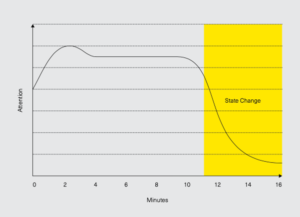How can we help?
Thank you for your enquiry, we will be in touch.
Oops! We could not locate your form.
Thank you for your enquiry, we will be in touch.
Oops! We could not locate your form.
Early on in my career, I took it personally when someone would yawn, fidget, or glaze over while I was presenting. Never mind how much animation and enthusiasm I was bringing to the room, or how well I’d prepared my content to be compelling, I’d see this sometimes. And it really bummed me out.
It wasn’t until I learnt more about the biology of the human attention span that I began to realise that I wasn’t actually the problem (well, certainly not the whole problem!). Popular opinion suggests that most of us have around a 10 minute attention span before our concentration tends to wane. And that’s the case even when the presenter is connected and the topic is relevant. Despite how interesting a subject is, our attention peaks at around three minutes, leaving a pretty small window to sustain our interest before it's gone.
I made a few tweaks to my presentations – and my mindset – to put this fact to good use.
Presenting, at its core, is all about respect – for your idea and for your audience.
A significant part of this involves respecting the time your audience is giving you, and the needs they have. That involves taking the time to understand them, and the circumstances they’re in.
A proportion of your energy while you’re presenting should always be reserved for reading the room. Look at how engaged your audience are and watch how they are responding. When you see any of the sleepy signs, bring in a ‘state change’ to manage attention and restore the energy in the room.
Science refers to a state change as the change from one state (solid or liquid or gas) to another without a change in chemical composition. It often comes about through a loss or absorption of energy. A state change in presenting is, similarly, a response to shifting energy.
You don’t have to get super scientific to affect a state change either. It’s simply when you introduce a shift in your presentation to create interest. It could be as simple as sharing an interesting story or relevant anecdote if the rest of your presentation is packed full of facts.
Other state changes include:
And perhaps the most underrated of them all: a well-deserved break (time permitting).

State changes are imperative – especially in a longer presentation when you’ve got a lot of ground to cover. The best conference organisers know how to work state changes into an event to keep things interesting across the day, but you can bring this understanding into a single presentation too.
If you’re delivering an hour-long presentation, consider breaking the time up with state changes to optimise your audience’s ability to focus. Or, if you’re presenting to a group straight after lunch, in a cosy warm room or – even worse – after the workday is done, bring in state changes to keep things fresh.
It’s not a silver bullet for presentations – you’ve still got to get the basics right – but even small state changes can be an effective way to make sure people are actually engaged and listening.
Keep up to date with the latest tips and resources by joining our mailing list.